Developing Course Units
A unit is a part of a subsection that learners view as a single page.
A unit contains one or more components, such as text with HTML markup, problems, a discussion, or a video.
In Studio, when you select a unit name in the outline, the Unit page opens.
The following example shows a unit page in Studio with two components, with circles and text to show different areas and controls in the page.
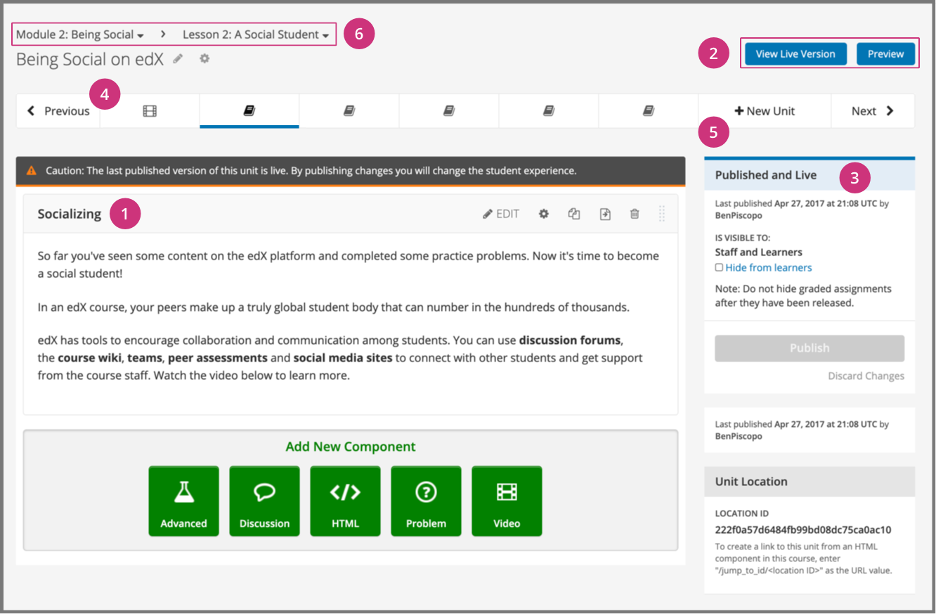
- A component in the unit.
- Options for testing the unit.
- Status panel for the unit.
- A unit navigation bar that shows where in the subsection this unit is located and provides easy navigation options to nearby unit pages.
- A way to add new units to a subsection through the unit navigation bar.
- Navigation tools to quickly get to other sections or subsections.
Create a Unit
You can create a unit from the outline or create a unit in the same subsection from the unit page.
To create a unit from the outline, follow these steps.
- In the outline, expand the subsection in which you want to create a new unit.
- Click New Unit. A new page opens for you to add components to the unit.

- On the unit page, the unit name is selected. Supply an identifying name. A descriptive name can help learners locate content in the course. It can also help you select content when you analyze performance in edX Insights.
- Add components to the new unit as needed.
To create a unit from a unit page, follow these steps.
- Click the New Unit button in the Unit Navigation Bar area.
- The unit page for the new unit opens automatically.
- On the unit page, the unit name is selected. Supply an identifying name. A descriptive name can help learners locate content in the course. It can also help you select content when you analyze performance in edX Insights.
- Add components to the new unit as needed.
You must then publish the unit to make it visible to learners.
Edit a Unit
You can edit a unit in the following ways.
- Edit the unit name
- Add Components to units
- Reorganize Components in Units
When you make any of these changes if you previously published the unit, the state changes to Draft (Unpublished Changes). You must then publish the unit to make your edits visible to learners.
If you are designing your course to offer different content to different groups of learners, you can also set access restrictions for the unit to specify which learner groups a unit is available to.
Edit the Unit Name
To edit a unit name, on the unit page in Studio, click Edit then next to the name.

The name field becomes editable. Enter the new name, and then click outside of the field to save the name.
Reorganize Components in Units
You can reorganize components within a unit by dragging and dropping them to new locations.
To change the location of a component, move your mouse pointer over the Drag to reorder the handle on the component toolbar. The pointer changes to a four-headed arrow. You can then drag the component to the location that you want.
In the image that follows, the handle for the discussion component is selected.
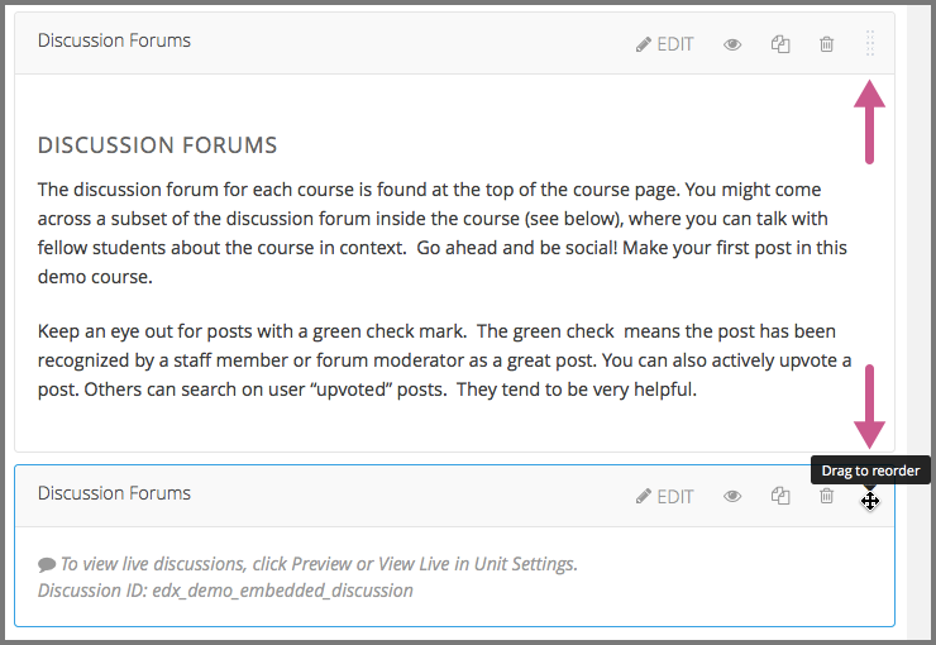
A blue outline indicates where the component will land when you release the mouse button. For example, in the image below, the discussion component is being moved to the top of the unit.

Set Access Restrictions For a Unit
If you have more than one enrollment track in your course, or if you have enabled cohorts, you can limit a unit’s availability to specific groups of learners. For information about offering different content to different learner groups, see Offering Different Content to Different Learner Groups.
A unit’s group access settings are inherited by components in the unit. If you set additional group access restrictions for a component, make sure the component access settings do not contradict the unit access settings. For example, you cannot give Group A of learners access to a component if Group A does not have access to the unit that contains the component.
To specify a unit’s access settings, follow these steps.
- In Studio, click Content, and then select Outline.
- For the unit that you want to restrict access to, select the Configure icon in the unit’s toolbar.
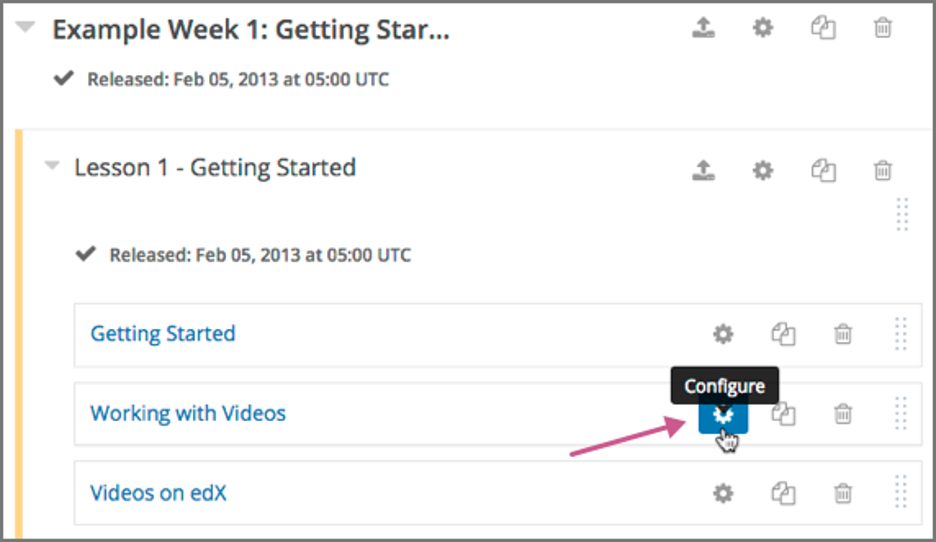
- You can also access the Restrict access to option from the gear icon next to a unit’s name on a unit page in Studio.

- In the unit’s Settings dialog box, for the Restrict access to option, select the group type by which you want to restrict access.
- The Content Groups option is available only if you have created content groups for use with cohorts.
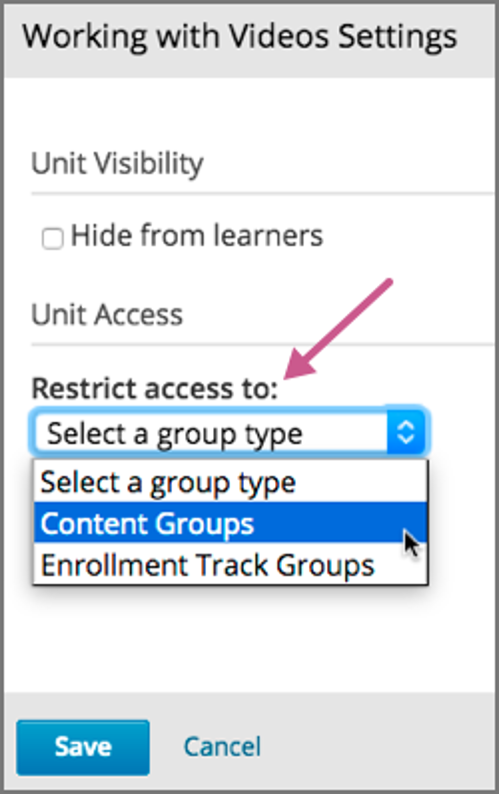
- After you select a group type, you see a list of the groups that exist for that group type.
- Select the checkbox for each group for which you want the current unit to be available.
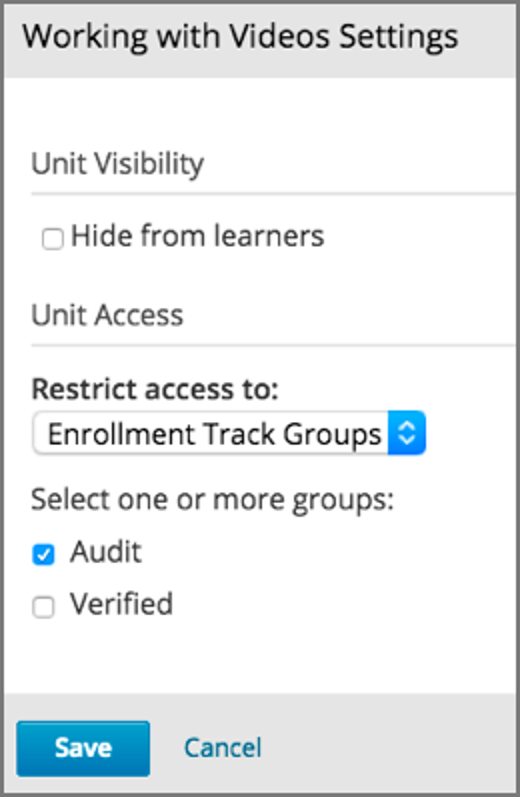
- Click Save.
The groups which have access to the unit are listed under the unit title in the Studio course outline, as well as under the unit title on the unit page in Studio.

Publish a Unit
To publish a unit from the outline, select the Publish icon in the box for the unit. You can also publish a unit from the unit page.
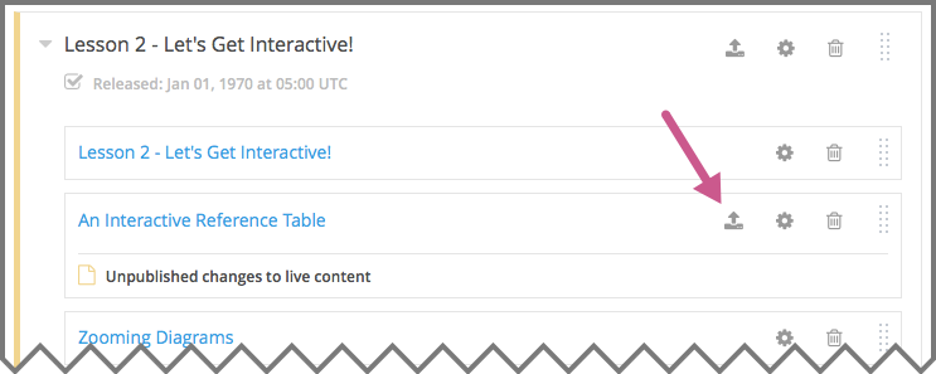
Hide a Unit from Learners
You can prevent learners from seeing a unit regardless of the unit status or the release schedules of the section and subsection.
- Select the Configure icon in the unit box.

- The Settings dialog box opens.
- In the Unit Visibility section, select Hide from learners.
- Click Save.
Delete a Unit
You delete a unit from the course outline in Studio.
When you delete a unit, you delete all components within the unit.
You cannot restore course content after you delete it. To ensure that you do not delete any content that you need later, move the unit to a hidden section or subsection instead of deleting it.
To delete a unit, follow these steps.
- On the course outline page in Studio, click the Delete icon in the box for the unit you want to delete.

- When you receive the confirmation prompt, click Yes, delete this unit.
